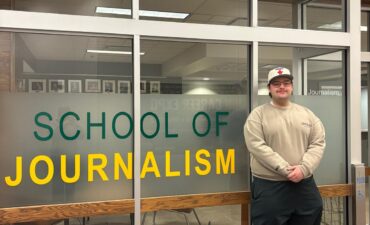
With approximately 4,500 residents on Cowessess First Nation, there are only 10 fluent speakers of Indigenous languages on the reserve, most of whom are elderly. Weekly classes seek to reawaken these “sleeping” languages. Cree and Saulteaux, collectively known as nehiyaw in Cree, are now taught to a group of 20 some students. Funded through Heritage Canada and supplemented by the Cowessess Health Department, the “Reawakening Languages” program is considered one of three pillars of the community.
Chief Cadmus Delorme of the Cowessess First Nation said reawakening Indigenous languages is one of the priorities of his leadership.
“You have to have three things … you have to have land, law, and language,” said Delorme. “We have the land, we’re working on our laws but our language was lacking”.
Sandy Pinay-Schindler, education director at Cowessess First Nation said when she started her position last November, Chief and council determined language development to be a community priority. Pinay-Schindler then submitted a grant application, which was later supplemented by the Health Department, for roughly $90,000 for the program’s implementation year. Funds are used to bring in instructors, or anishnabae, Margaret Cote and Darren Okemaysim to teach Saulteaux and Cree respectively, as well as to create a language camp for the summer of 2019.
Despite the program being in its early stages, Delorme said positive effects are already seen around the community.
“We’ve seen changes,” said Delorme. “Just for example nookum. Nookum means ‘grandmother,’ I’m not knowing where in the history, but people say kookum, that’s a mispronunciation that means ‘your grandmother’ so I’m already hearing people say nookum rather than kookum. Even little adjustments like that, I’m already seeing positives.”
The Reawakening Languages initiative has resonated strongly with elders of the community despite some challenges. Andrew Starblanket, an elder helper with the program, said elders may have negative memories in learning Indigenous languages due to residential school trauma.
“A lot of things trigger,” said Starblanket, who also works as a Cree teacher at the Cowessess Community Educational Centre. “When you look at a lot of structures in the building, we’re doing it in an old church and so those things affect them.”
Despite some challenges that may arise Delorme says the program is an important element in healing. “Now, instead of laughing at each other we laugh with each other . . . And sometimes they’ll say my grandpa or my grandma, I remember them saying this word. And it’s as if they’re recalling their childhood and its happy times . . . as we reconcile our past, the language is going to help us in our healing journey.”
Not only has the Reawakening Languages program resonated with the older generation, but the younger generation is seeing benefits as well. Darian Agecoutay, a student of Cree language literacy at the First Nations University of Canada, said he was inspired to learn Cree when he moved to Regina to attend his post-secondary education.
“When I got to the University I saw how much the language was dying and young people especially were not using the language, so that’s why I tried to take initiative” said Agecoutay, who is also working toward his environmental science degree. “Our culture, history and identity is intertwined within the language. If we lose the language then we lose a part of ourselves.”
Agecoutay said the program on Cowessess is encouraging and hopes more people of his generation take an interest.
“My relatives that live there, I go back and speak Cree to them and they’re surprised . . . It creates interest from people my age because they want to be like that.”
Despite an encouraging beginning to the Reawakening Languages program, Delorme says there are steps that need to be taken, including more funding through Heritage Canada over the long term and investments in language programs such as Rosetta Stone. Those on Cowessess are not complaining however, as the nehiyaw languages begin to reawaken. With Cowessess being the first Indigenous community to receive a two-year funding grant, the program is a pilot project for much of the country. Agecoutay thinks the initiative can inspire more programs across Canada.
“To know Canada you have to know what the Indigenous people went through,” said Agecoutay. “To know the history is to know the Cree people and to know the Cree people is to know Canada.”











